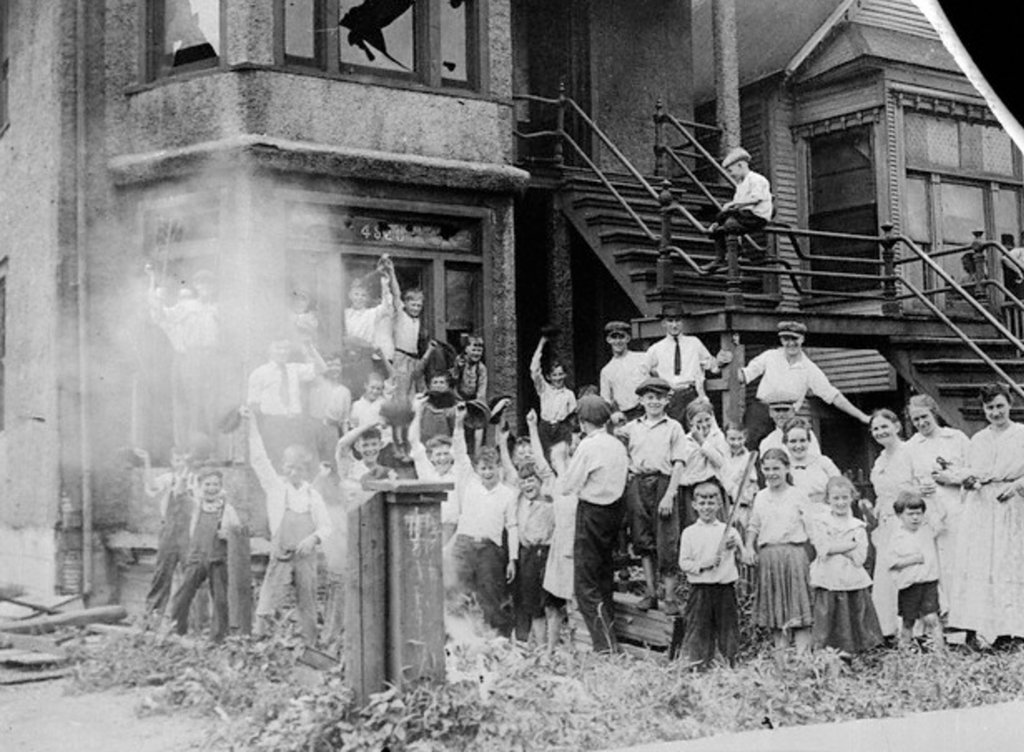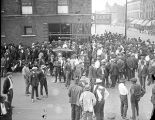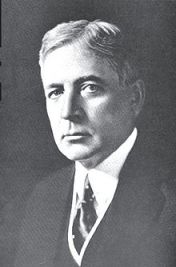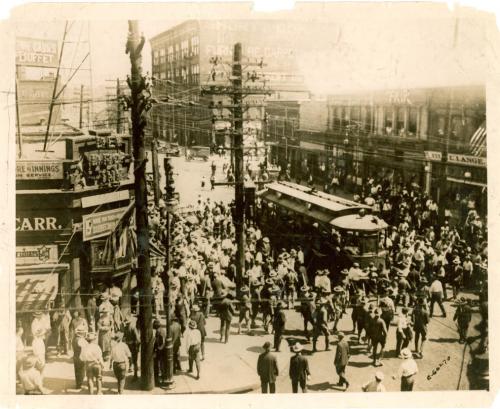On the third day of the Chicago’s Race Riots, another level of chaos was added to the fighting. The streetcar workers went on strike. Starting at 4 a.m., surface and elevated trains stopped running. This left no transportation for workers attempting to commute into the Loop or to the Packing Houses. The shutdown meant the nation’s main stockyards were closed. Mail was delayed. Financial markets dropped.
WARNING: SOME OF THE IMAGES BELOW CONTAIN GRAPHIC VIOLENCE
Many Black Workers Stayed Home
The city ordered 1200 black municipal employees not to report to work. Most black Packing House workers elected to stay at home. Only 19 of Armour Packing Company’s 1500 black employees showed up for work; only 23 of 2,5000 at Swift; with Morris, Wilson and other packers reporting low turn-out as well. (Source: Tuttle) In order to get to their jobs, blacks had to cross the Back of the Yards—the primarily Irish neighborhoods “policed” by the athletic clubs. This was enemy territory. Most decided not to chance it.

Back of the Yards Neighborhood
Staying home was a wise choice. A July city ordinance outlawed concealed weapons, so blacks faced a choice: don’t carry a weapon and risk being unarmed if attacked, or carry one and risk arrest. (Source: McWhirter) Some black workers who tried to report to work were killed. Edward W. Jackson was beaten to death by five white men on his way to work at a South Side factory. White workers were also killed. A Polish railroad worker was shot and a Jewish shop owner stabbed to death. (Source: McWhirter)
Blacks who traveled to work in the Loop were primarily service workers: waiters, kitchen help, shoeshiners, porters at hotels and Pullman Porters.
The Loop was in Chaos
Nearly the entire Chicago police force had been pulled to the South Side, surrounding the Black Belt to discourage white gangs from entering, and to break up ongoing fights between blacks and whites. This left the entire Loop virtually unprotected. One estimate put the total number of police in the Loop at four—three officers and one sergeant. (Source: Krist) None of the city’s 175 traffic cops or 75 mounted police were on duty. One hundred unpaid civilian directed traffic in the city’s center, only half of the volunteers the city had asked to step forward. (Source: McWhirter)

Marshall Fields During Calmer Times in 1919 (Tumbler)
With no public transit, Chicago residents garnered any transportation means possible. Workers walked. Men hung on vegetable trucks and hitched rides on milk trucks, delivery trucks and furniture drays. Drivers turned their flatbed trucks into jitneys by lining the beds with kitchen chairs, sometimes charging exorbitant prices. Workers rode bicycles. Old carriages and surries were dredged out of storage and horses put again into service. (Source: Krist) Automobiles, trucks, carts, bicycles and wagons clogged the streets—all driving toward the city’s center.
The sights and sounds had to be almost comical. Engines rattling, hoofs clapping, bicycle bells ringing. One young boy reportedly pointed to the stream of assorted transportation modes, delighted by the “circus parade.”
Brutal violence Broke Out in the Loop
Blacks workers in the Loop were targets. With virtually no police presence, white gangs went on a rampage. They pulled black service industry workers out of restaurants and hotels, and workers out of factories, and beat them on the streets. A white mob chased a black man into a lunchroom as he fought them off by hurling cups and plates. The mob eventually captured him, beating him and trying to drown him in a sink. The man was saved by a police officer. White mobs also attacked Pullman Porters at the train stations and black barbers at all-night barbershops. (Source: McWhirter)

Whites Attacked Black Workers Throughout the City: the Black Belt, Back of the Yards, West and North Sides and Even in the Loop

Police on the Scene After the Murder (Jun Fujita)
To quell the rioting, police set up roadblocks to deter more blacks from entering. By noon, the Loop’s black workers had disappeared. Restaurant owners waited their own tables or closed. Even the dining room of the Palmer House shut down. (Source: McWhirter) A group of 500 had stormed the Palmer House to attack its kitchen employees, shooting one black and stabbing another, as the terrified workers raced to escape their attackers and other roving mobs. Hundreds of onlookers watched in shock. (Source: Krist)
Violence Spread North and West
On the North Side, “nearly 5,000 whites hunted down black people in the streets.” (Source: Tuttle) An apartment building where 100 black men, women and children lived was inundated by a mob of Sicilians. In the Gold Coast, white crowds took “potshots” at pedestrians and threatened violence against the black household help of rich whites.
White mobs attacked and killed blacks returning from work. A black cyclist on the Italian West Side was knocked from his bike, chased and dragged into the street where the mob “riddled his body with bullets, stabbed him and beat him.” (Source: Krist)

Police Remove the Body of a Black Man
Fighting Continued on the South Side
Though the police presence in the Black Belt thwarted big groups of rioters, smaller skirmishes continued. Gangs of both whites and blacks fought using bricks, knives and clubs. Cars of whites infiltrated the black neighborhoods, shooting indiscriminately. Black snipers took posts on rooftops and balconies. Any white in the Black Belt was a target—even police officers.
One report cited a group of 12 armed black soldiers patrolling the South Side and shooting at whites. The men were reportedly former members of the old 8th Division. (Source: Krist)
The Cook County Coroner had jury members, under oath to do their duty, visit riot scenes to view the corpses. (Source: McWhirter)

Whites Burned and Damaged Black Homes, Stealing or Throwing Valuable onto the Street
A black worker walked 5 ½ miles toward home only to be knocked down at 22nd and Halsted streets, his face stomped. A Jewish peddler took the victim to the Black Belt in his cart, but the man was refused treatment as he had no money.
By night, the Black Belt erupted anew. Nonfatal shootings increased, especially shootings of police. A shootout at Provident Hospital left three officers wounded. Blacks shot at whites from their darkened homes. And now a new horror faced residents mostly of the Black Belt—entire multi-unit homes were set ablaze. Attempts by police and firefighters to respond were met with bullets, bricks and stones. (Source: Krist)
Rumors Ran Rampant
Police surrounded city hall with 60 armed detectives to protect it and the Mayor against a rumored mob assault. False rumors that blacks planned to systematically burn down white homes on the South Side caused alarm, driving the Fire Marshall to hold all city firemen in reserve. (Source: McWhirter) Rumors swirled that blacks had stores of weapons and ammunition, and that they were breaking into armories, preparing to invade.

The Infamous Bubbly Creek – a Fork of the South Branch of the Chicago River Where So Much Organic Waste Flowed from the Meat Packing “Disassembly” Factories and Industrial Plants, the Creek Literally Bubbled (Steven Casey)
Other rumors were perpetrated by both the white and black press. A black man was hanged from a building on Madison Street. Blacks were killed and thrown into the Chicago River and “Bubbly Creek” in numbers ranging from 4-100. Black men were attacking white women, especially in the stockyards district. A white child was snatched and dismembered by blacks. The Defender claimed a white mob killed a black woman attempting to board a car, cutting off her breasts and displaying them on a pole, and beating “the baby’s brains out against a telephone pole.” The Chicago Daily Tribune reported that the body of a slain black cyclist was saturated with gasoline and set on fire, calling it “the most atrocious lynching of the whole series of murders.” (Sources: Tuttle, McWhirter, Krist, Chicago Tribune archives)
All were untrue. No women or children died, and only ten women were hurt during the rioting. And although the black cyclist had indeed been stabbed and then shot 16 times due to rumors in the Italian neighborhood that a black man had murdered a neighbor girl, the victim’s body was not set on fire. (Source: Tuttle)
The newspaper stories incited more violence, and the constant daily injury and death tallies, which were sometimes incorrect, inspired a feeling that the sides needed to “even the score.” (Source: Krist)
That evening, rumors that Provident Hospital, a mainly black hospital, was treating two white patients, caused angry blacks to engage in a shootout on the street with police. (Source: Krist)
Black Leaders Meet. Some Ask for Calm.
Wells-Barnett met with representatives from every black congregation in the city, each reporting on the violence in its neighborhood, with all in attendance trying to decide what to do. Carl Sandburg reported on this meeting and an interview with Dr. George C. Hall of the National Urban League, in his articles for the Daily News. (Source: Krist)
Handbills, created by Chicago Defender publisher and two other black businessmen, asked blacks to stay inside and obey police. “This is no time to solve the Race Question.” (Source: McWhirter)

Blacks in the Streets (Chicago History Museum)
Racial Discrimination Caused Black Outrage
Blacks were killed, hurt and arrested in disproportionate numbers to whites. Roughly twice as many blacks as whites were being arrested, while double the amount of blacks were being killed and injured on the streets. In one instance, a group of 12 blacks and whites was arrested for carrying concealed weapons; yet, the whites were set free and given back their ammunition and told, “You’ll probably need this before the night is over.” (Source: Krist)
In an article on the front page of Tuesday’s Daily Journal Ida B. Wells-Barnett, chided the city and called for the formation of a biracial committee to immediately address the violence. (Source: Krist)
“Free Chicago stands today humble before the world. Lawless mobs roam our streets. They kill inoffensive citizens and no notice it taken. They are Negroes—they are only Negroes—and it doesn’t matter. …[Chicago] is weak and helpless before the mob. Notwithstanding our boasted democracy, lynch law is king.”
Ida B. Wells-Barnett
A black weekly, the Broad Ax, blamed the current violence on Mayor Thompson’s inaction in addressing past bombings of black homes and his refusal to meet with Wells-Barnett and her committee that June. Thompson’s enemy, Victor Lawson, took the opportunity in his paper, the Daily News, to accuse Thompson of catering to the blacks for votes, but only being “able to harvest a crop of race riots.” (Source: Krist)
Dysfunctional Government Delayed the Release of the National Guard
Waiting behind the scenes were thousands of National Guard. Four regiments of the militia stood ready at armories across the city. All Tuesday, the militia waited while the killing continued outside.
So why wasn’t the National Guard allowed to act?
Sadly, the reason was political. The Mayor and the Governor were at a standoff. Both sought the Republican presidential nomination for 1920, so neither politician wanted to be the one to call in the militia.

Mayor Big Bill Thompson was Flamboyant And Colorful. His Refusal to Call in the National Guard During the Outbreak of the Riot Led to More Deaths and Injuries (Chicago Tribune)
Mayor Big Bill Thompson didn’t want to appear weak and ask for the help from Governor Frank Lowden, his political enemy. Besides, Thompson’s advisors reported that things were under control. The head of the militia, General Frank S. Dickson, and Charles Fitzmorris, Thompson’s private secretary, had together toured the riot districts that morning and did not sound alarm. (Source: Krist)

Governor Frank O. Lowden Also Refused to Send in the Militia, Though He had the Power to Do So
Governor Lowden was also hesitant to act. He enjoyed seeing his enemy suffer. Plus, Lowden knew that Thompson would head the delegation at the upcoming Republican National Convention so didn’t want to cause tension by overriding Thompson’s authority. (Source: Krist)
Both men feared that bringing in the National Guard could repeat the chaos and atrocities of the East St. Louis, Illinois riot, where, two years earlier, the National Guard and local police had added to the mayhem by participating in attacks and murders—shooting, burning, and hanging blacks. The death toll had reached 40, leaving hundreds wounded. It had taken three days for a battalion of troops to arrive from Springfield. (Source: Tuttle)

A Mob Stopped a Street Car During the Bloody East St. Louis, Illinois Riots of February 1917
In addition, neither leader wanted to ask the Chicago commander of military installations in the Midwest, Major General Leonard Wood, for help. Wood, a contender himself for the presidency in 1920, would then be the hero if the troops were successful in reigning in the violence. General Wood chose not to involve himself in suppressing the riot, although he had his own authority to do so; and Mayor Thompson did not act on his power to ask for Wood’s assistance. (Source: McWhirter)

President Woodrow Wilson (Harris Ewing WIKI)
Thompson and Lowden also had the option to ask for help from the president; but, neither Republican wanted request Federal help from the Democratic president, Woodrow Wilson.So both waited it out—Mayor Thompson, in City Hall, and Governor Lowden, in the Blackstone Hotel.
Lowden released a statement saying he would gladly send in the militia if martial law was formally requested; and, Thompson, in turn, said that Lowden could send in troops on his own authority. Meanwhile, the troops sat idle.
Midday-Midnight: Still No Troops
The two politicians met briefly midday at the Blackstone and reported at a news conference that the worst of the rioting was over and that they were “cooperating heartily.” Chicago Police Chief Garrity said, “Things are quieting down steadily. The police have [the situation] as well in hand as it could possibly be.” (Source: Krist)

The Blackstone Hotel was Governor Lowden’s temporary Headquarters During the 1919 Riots
“We found the situation much improved. The commanding officers reported a great change in feeling since last night and an improved out look and disposition on the part of the people generally. All the commanding officers we talked with felt they had the situation well in hand, and did not anticipate any recurrence of the deplorable events of last night.”
General Frank S. Dickson, head of the militia at Tuesday’s news conference (Krist)
This was blatantly untrue. The morning had been bloody. Hundreds of black arrestees rioted at the city jail just as the news conference reported all was well.

Man with Machine Gun at the City Jail Where Black Prisoners Had Rioted
Stopping briefly in the hottest part of the day, the violence rose up again. Chicagoans on both sides were still being shot, stabbed and beaten over dozens of square miles of the city. Meanwhile, combat-ready troops sat nearby, waiting for orders. (Source: McWhirter)
At midnight, Mayor Thompson decided to go home without sending in troops, saying he would “not ask for the state troops before morning. I will await developments.” (Source: Krist)
By Tuesday’s end, 11 more blacks and whites were dead and 139 severely injured. (Source: McWhirter)
Hoodlums, by Carl Sandburg
Reporter and poet Carl Sandburg was so distraught by the violence, he penned his famous poem “Hoodlums” that night, written from the point of view of a rioter:
Hoodlums
I AM a hoodlum, you are a hoodlum, we and all of us are a world of hoodlums—maybe so.
I hate and kill better men than I am, so do you, so do all of us—maybe—maybe so.
In the ends of my fingers the itch for another man’s neck, I want to see him hanging, one of dusk’s cartoons against the sunset.
This is the hate my father gave me, this was in my mother’s milk, this is you and me and all of us in a world of hoodlums—maybe so.
…
Let us go on, brother hoodlums, let us kill and kill, it has always been so, it will always be so, there is nothing more to it.
Let us go, sister hoodlums, kill, kill and kill, the torsos of the world’s mothers are tireless and the loins of the world’s fathers are strong—so go on—kill, kill, kill.
…
Sources
Gary Krist; City of Scoundrels: The 12 Days of Disaster that Gave Birth to Modern Chicago; Crown Publishers; 2012
Cameron McWhirter; Red Summer: The Summer of 1919 and the Awakening of Black America; St. Martin’s Griffin; 2011
William M. Tuttle, Jr.; Race Riot: Chicago in the Red Summer of 1919; University of Illinois Press/Urbana and Chicago; 1996
“One Death in 14 Hours Puts Total at 26”; The Chicago Daily Tribune; Wednesday, July 30, 1919; archives.chicagotribune.com
“Then & Now: Bubbly Creek – Chicago”, The Herald News; Published Sunday, Dec 20, 2015
“Hoodlums”; Carl Sandburg; written Chicago, July 29, 1919; Smoke and Steel, 1922
So interesting, Tamara! Thanks for sharing!
Sent from my iPhone
>
LikeLike
Thanks Michelle! Appreciate your response. Tamara
LikeLike